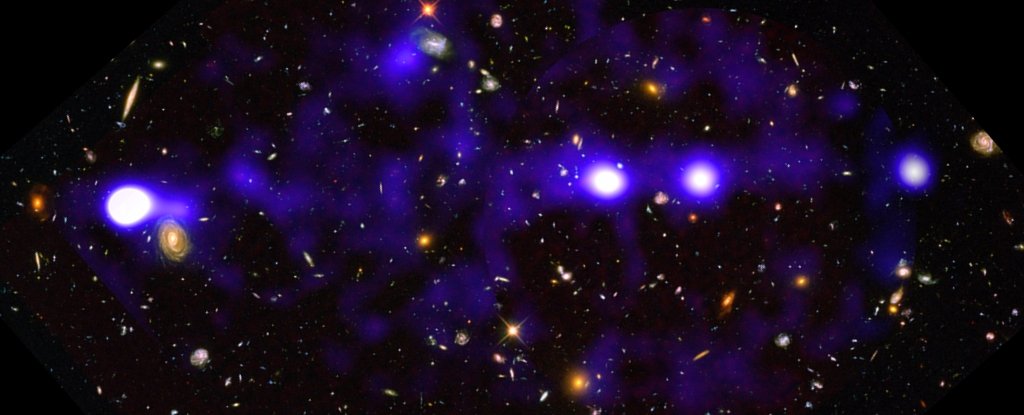
While the Universe is a big place, and all the stuff in it just seems to be thrown out all over the place, scattered and torn, there is quite a bit more structure than we can see.
According to our models of the Universe, and growing evidence, filaments of dark matter connect massive objects such as galaxies and galaxy clusters in a vast cosmic web.
Hydrogen flows along these filaments and feeds into the galaxies, but they are not that easy to see – among all the brightly glowing stars and galaxies and galactic nuclei, the faint emission of diffuse hydrogen in intergalactic space is hard to see, never mind map.
However, we have just come a step closer. After years of work, an international team of astronomers led by Roland Bacon of the Lyon Astrophysical Research Center in France has just directly imaged several filaments of the cosmic web in the early Universe, about 12 billion light-years away.
 Hydrogen filaments (in blue). (Roland Bacon / David Mary / ESO / NASA)
Hydrogen filaments (in blue). (Roland Bacon / David Mary / ESO / NASA)
Their results are not just some of the strongest evidence yet for the cosmic web; they also found evidence that a large population of dwarf galaxies powers the hydrogen glow in the filaments. This discovery could drastically change our understanding of galaxy formation in the infancy of the Universe.
Because the cosmic web is so difficult to see, much of our evidence so far has been circumstantial. Some scientists have used the way mass bends space-time – gravitational lenses – to look for curves in the path of the distant light, suggesting that a strand of the cosmic web is between the source and us.
Other researchers use the light from quasars, extremely bright distant galaxies, to search for light absorbed by hydrogen along the filaments.
 (Jeremy Blaizot / SPHINX project)
(Jeremy Blaizot / SPHINX project)
Above: Cosmological simulation of the distant Universe, with light emitted from hydrogen atoms in the cosmic web about 15 million light-years across.
Bacon and his team took a different approach: they stared for a very, very long time at a tiny slice of sky with a truly amazing telescope. Using the MUSE instrument from ESO’s Very Large Telescope in Chile, the team took a whopping 140 hours of observations of part of the sky that was also seen in the Hubble Space Telescope’s Ultra-Deep Field.
Similar research had been done, where astronomers looked for strands of light in a cluster of galaxies – gas threads ionized by the galaxies themselves. Again, the work of Bacon’s team differs from previous efforts: The earlier study investigated an extreme environment, while the new study looked deliberately unremarkable.
After the planning phase, it took months to obtain the team’s observations, from August 2018 to January 2019. They had to be taken in blocks during the new moon to minimize interference.
 (Thibault Garel / Roland Bacon)
(Thibault Garel / Roland Bacon)
Above: Cosmological simulation of a filament made up of hundreds of thousands of tiny galaxies (seen in situ on the left, seen through MUSE on the right).
The team then had to process and analyze the data, which took another year. But it was worth it – not only were 40 percent of the galaxies in their data undetectable in the Ultra Deep Field, but the researchers had also imaged glowing hydrogen in filaments of the cosmic web spanning millions of light years.
Fascinatingly, the team’s analysis shows that most of the hydrogen emission can be explained by a large population of star-forming dwarf galaxies scattered along the filament. We can’t see them separately, of course – they are far too distant to solve – but future work could help confirm this discovery, with huge implications for our understanding of the universe.
If dwarf galaxies are also guided along cosmic web filaments, like water droplets along a string, it could help explain how galaxies formed and grew – and grew to miraculous sizes in the early Universe, a question that has baffled cosmologists.
In addition, looking for the emission from star-forming dwarf galaxies could help us find more filaments of the cosmic web and a better understanding of how everything in the Universe is connected.
The research is published in Astronomy and Astrophysics